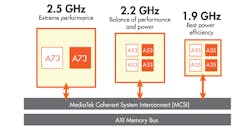10-core SoC Targets Premium Mobile Media Devices
The hottest embedded devices are mobile media platforms like smartphones, and the higher-end smartphones pack the latest multicore SoCs. The challenge is delivering performance while reducing power requirements to extend the battery life of these devices.
MediaTek’s 10-nm, Helio X30 packs in 10 ARM cores in a tri-cluster architecture to power premium mobile devices. The third-generation chip can handle 4K video as well as deep neural network applications.
The tri-cluster architecture extends ARM’s big.LITTLE approach to three levels with the high performance operation utilizing a pair of 64-bit Cortex-A73 cores running at 2.5 GHz. Midrange operation is handled by a quad-core Cortex-A53 cluster that runs at 2.2 GHz. Low-power operation is handled by another quad core cluster of ARM Cortex-A35 running at 1.9 GHz. There is also a separate Cortex-M4 that operates as a sensor integration platform.
MediaTek’s Core Pilot scheduler manages the tri-cluster operation. Core Pilot 4.0 brings advanced energy-aware scheduling to software platforms like Android. It automatically switches between clusters to optimize performance and power utilization. The memory subsystem supports four 16-bit, 1866 MHz LPDDR4, eMMC 5.1 and UFS 2.1.
The SoC incorporates Imagination Technologies’ PowerVR Series7XT Plus GPU. The multicore GPU runs at 800 MHz. It delivers 2.4 times the performance of the previous generation with a 60% power savings. It can handle 4K2K, 10-bit HDR10, and 30 frame/s video encode and decode. The virtual reality software support is designed to handle platforms like Google Daydream.
There is also a programmable Vision P5 vision processing unit from Cadence’s Tensilica. This provides faster auto exposure operation. The system can handle a 28 Mpixel or dual 16 Mpixel camera system. It can handle dual camera optical zoom. The Electronic Image Stabilization Plus (EIS+) 3.0 system combines image and gyro information to deliver smoother video recording.
The SoC is designed for wireless communication. It can handle a range of protocols including Wi-Fi 11ac, Bluetooth, FM, GPS/Glonass/Beidou navigation, and ANT+ devices. The modem is a Cat-10 worldmode 4G LTE modem with 3x DL CA. It delivers LTE 450 Mbit/s download speeds and 150 Mbit/s upload speeds. It can handle LTE-U/LWA band support as well as LTE FDD/TDD R12. The second-generation envelope tracking module (ETM 2.0) is available as is TAS 2.0 smart antenna technology support.
About the Author
William G. Wong
Senior Content Director - Electronic Design and Microwaves & RF
I am Editor of Electronic Design focusing on embedded, software, and systems. As Senior Content Director, I also manage Microwaves & RF and I work with a great team of editors to provide engineers, programmers, developers and technical managers with interesting and useful articles and videos on a regular basis. Check out our free newsletters to see the latest content.
You can send press releases for new products for possible coverage on the website. I am also interested in receiving contributed articles for publishing on our website. Use our template and send to me along with a signed release form.
Check out my blog, AltEmbedded on Electronic Design, as well as his latest articles on this site that are listed below.
You can visit my social media via these links:
- AltEmbedded on Electronic Design
- Bill Wong on Facebook
- @AltEmbedded on Twitter
- Bill Wong on LinkedIn
I earned a Bachelor of Electrical Engineering at the Georgia Institute of Technology and a Masters in Computer Science from Rutgers University. I still do a bit of programming using everything from C and C++ to Rust and Ada/SPARK. I do a bit of PHP programming for Drupal websites. I have posted a few Drupal modules.
I still get a hand on software and electronic hardware. Some of this can be found on our Kit Close-Up video series. You can also see me on many of our TechXchange Talk videos. I am interested in a range of projects from robotics to artificial intelligence.


